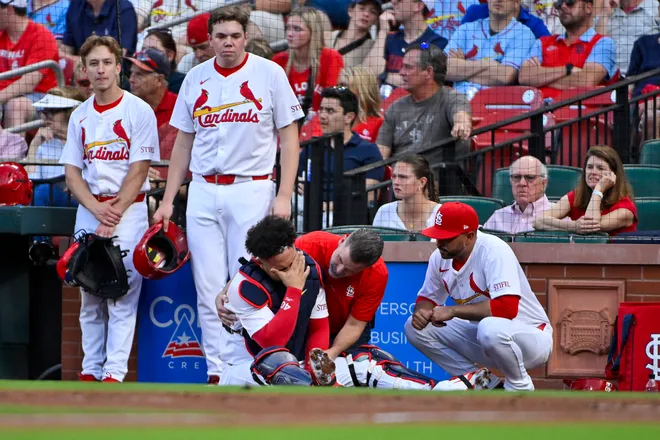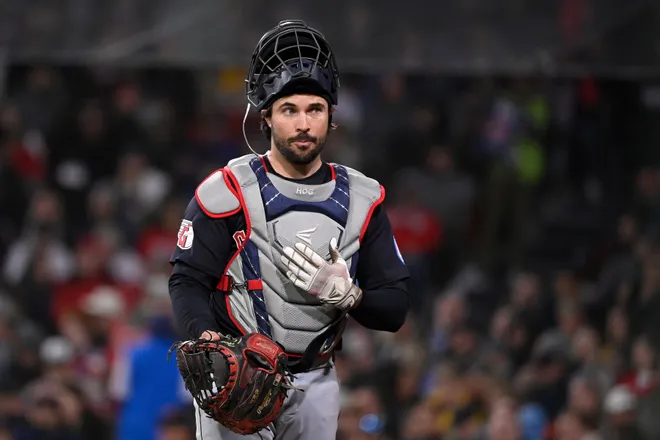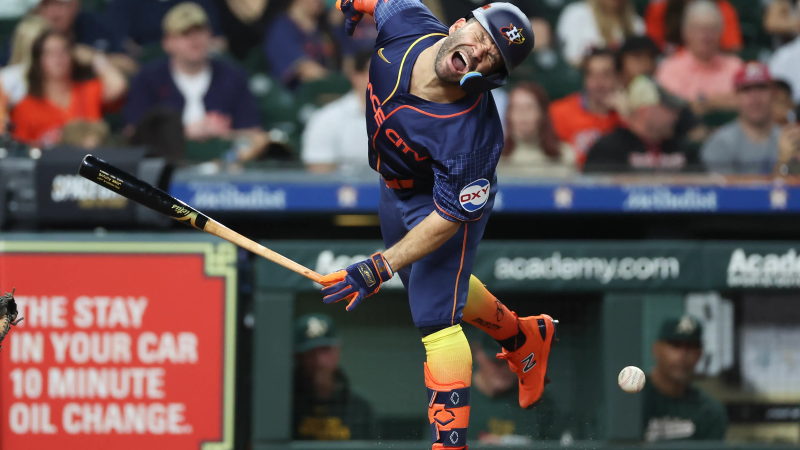MLB may have to act on strike-stealing after catcher's gruesome injury: 'Classic risk-reward'
It is no longer a game of inches but rather a contest of countless data points. And when the modern baseball player is armed with information that can win them a strike, an out, a game and ultimately, a few more lucrative earning years, no risk is too large.
And that’s largely how a small patch of dirt between batter and catcher has turned into a battle zone.
When a swing from New York Mets designated hitter J.D. Martinez fractured St. Louis catcher Willson Contreras’ left forearm May 7, the obsession with – and inherent problems stemming from – framing pitches and stealing strikes came into stark relief.
Contreras, in the second year of a five-year, $87.5 million contract, will miss about 10 weeks due to the injury, a big price for the struggling Cardinals – especially when the benefit was simply gaining one extra strike for his pitcher.
The obsession with pitch framing – strike-stealing, or strike-preserving, depending on one’s perspective – isn’t going away, at least in the absence of a fully automated strike zone. Yet Major League Baseball’s concern with the problem – which predates the Contreras-Martinez incident – may prompt the league to bring the matter before its competition committee if teams and players cannot correct the rise in incidents themselves, according to a person familiar with the league’s thinking who spoke to USA TODAY Sports on condition of anonymity because they were not authorized to speak publicly.
Follow every MLB game: Latest MLB scores, stats, schedules and standings.
The league has reason to act: Catcher’s interference calls are at an all-time high.
Through Sunday, there have been 35 violations for catcher’s interference, which is called when a batter’s swing strikes the catcher’s glove before coming through the strike zone.
With the season barely one-quarter complete, the 35 violations already exceed the entire 2015 season’s total of 33. After that season, catcher’s interference calls began a steady rise, and increased 57% from 2021 to 2023, when it peaked with 74 violations – a mark that will be obliterated this year, perhaps by the All-Star break.

That line of demarcation is probably no coincidence: 2015 was the first year MLB produced Statcast data, which, in concert with third-party tools such as high speed cameras and other tech, changed the way the game is analyzed, valued and ultimately played.
For catchers, it’s meant creeping ever closer to the batter, largely aiming to stop the ball’s flight before it dips below the strike zone. No matter the danger.
“I think at the end of the day, nothing will change because it’s valued so much in terms of what you bring to the position, value to your team and ultimately to yourself in terms of getting paid,” catcher Tucker Barnhart, an 11-year veteran, told USA TODAY Sports. “It’s kind of a double-edged sword: If you don’t do it, you don’t play and you don’t get paid.
“And if you don’t do either of those, you’re not going to be in the game very long.”
Barnhart debuted in 2014, when, he said, framing was “kind of an afterthought” after blocking balls, nabbing basestealers and then receiving ability.
Now, he says, “It’s the complete inverse.”
The tools of ignorance have given way to countless contraptions. More than a dozen teams have invested in a Trajekt Arc pitching machine, a robot that’s loaded with Statcast pitching data for both opponents and teammates. A catcher can test-drive a pitcher’s repertoire and know exactly where to set up to snag a strike or two.
Advance scouting meetings are replete with information on how to best set up a hitter, which may involve creeping closer to his stance. And there’s plenty of dirt on the guys with the longest, and ostensibly most dangerous swings.
“Hey, you have to be aware,” says Baltimore Orioles veteran catcher James McCann. “Anyone can get you at any one time. But there are more guys that, based on their swing types, are a little more prone than other guys.
“One of the things we talk about before a series – this guy has multiples (catcher’s interference); be aware. It doesn’t mean you change anything; just maybe don’t go that far inside on him.”
Indeed, the book was already out on Martinez – a 6-3, 230-pounder who is particularly effective at letting the ball travel and pounding it to the opposite field. Shohei Ohtani, Luis Robert and Kyle Tucker are similarly long-limbed, long-swinging sluggers who consistently rank among league leaders in reaching base via interference.
But tendencies can run the gamut. Former Diamondback Josh Rojas is remembered by teammates for his knack to reach that way. Utilityman Tommy La Stella impacted playoff games and could make an entire highlight reel of his interference proclivity. Jacoby Ellsbury made history.
Yet even before Contreras’ injury, MLB had sounded the alarm on the rise in catcher interference. Now, in the wake of the Contreras injury, it again must ponder if it must intercede if teams don’t change their habits.
'The batter's box is mine'
You see it almost every game: The leadoff batter digs into the box and, should they feel sufficiently vested in their big league time, wipes out the chalk marking the back end of the batter’s box.
Hey, pitchers have always thrown hard. Every millisecond of swing decision time helps. And no, it’s not on the hitter to ensure his swing doesn’t strike glove when the catcher has total control of setting up.
“That’s my zone as a hitter. I don’t have to do anything to not hit the catcher,” says Arizona first baseman Christian Walker. “It’s his job to stay out of my way. The batter’s box is mine. Home plate is mine in that moment. As long as I’m in the box, that space is mine.
“I’m not up there thinking, ‘How can I stay out of his way?’ That’s on him. That’s why we get the base.”
Just as catchers know the swing paths of hitters, their counterparts know who’s best at stealing strikes. Framing statistics are now readily available, although proprietary scouting reports are probably even better at identifying the best pitch presenters.
You could also simply sort by batting average, pick out the lightest-hitting catchers and know why they’re around. The Cleveland Guardians brought back Austin Hedges as a backup even after he batted just .172 over the previous four seasons.
“Hedges is always elite, maybe the best in the league,” says Walker. “I remember taking some at-bats and him framing a breaking ball low and getting the call and looking down and his glove was in front of me. That’s how they’re doing it – they’re going and getting it.
“If they’re willing to take the chance that the hitter’s not swinging the bat and want to be vulnerable and go and get the pitch – props to them. That’s the classic risk-reward – it sucks that it can come at the (expense) of a real injury. It sucks for Contreras; it’s terrible. But also, you kind of know what could happen if that’s the game we’re playing.”

Danger zone
The cat-and-mouse between pitcher, catcher and batter won’t be going away soon. But nobody wants to see another Contreras situation.
To that end, MLB officials visited all 30 training camps this past spring and, as Arizona manager Torey Lovullo put it, “clearly defined the rules of where a catcher could set up and said they were going to monitor how close that catcher was to the batter.”
“Maybe it wasn’t monitored the way it needed to be. I know Contreras getting clipped is going to reignite that,” says Lovullo. “He’s a great player in this game; it’s very unfortunate. It’s got to be monitored and hopefully we can keep pushing that ball down the field.”
Yet it seems either teams, managers or catchers are not listening. The league made it a point of emphasis during sessions with all 30 managers at the winter meetings, and then again during spring training. But with the rise in catcher-bat contact, the league may present catcher’s interference to its competition committee as a potential safety issue.
The committee would then decide whether and how to legislate the issue and enforce it. The committee is comprised of six club representatives, four MLB Players’ Association reps and one umpire.
The committee has driven forward implementation on radical game-changing mechanisms, such as the pitch clock. It would now take aim at a craft players have diligently aimed to master.
Toronto Blue Jays catcher Alejandro Kirk currently ranks No. 1 in Statcast’s catcher framing metric, tied with the Yankees’ Jose Trevino and Colorado’s Elias Diaz in catcher framing runs while ranking fourth with a 51.7% strike rate.
His receiving ability was not innate, but rather crafted over years of diligent work and analysis with Blue Jays bullpen catcher and big league catching coordinator Luis Hurtado.
“We went to a lot of video, and figured out how to get better,” says Kirk through an interpreter. “He helped me a lot to get where I’m at now and there’s a daily routine that we stick to.
“We’re very conscious, for example, if a hitter has a long swing, and we work on that to try and get the space in between that. Others have shorter swings.”
Framing itself is also due to evolve. McCann says the publicly available data has some holes in it, most notably a failure to adjust to an individual umpire’s tendencies, which hurts catchers’ ratings when receiving specific pitchers.
Can strike-stealing get more granular? Never bet against technology.
But, Lovullo cautions, never take for granted the dangers inherent in optimization.
“The game has gotten very specific,” he says. “Catchers do know where the pitch is going and how to get a ball to be a strike. They want to get underneath the ball and bring it up, they want to get around the ball and bring it in.
“It takes a lot of work. It takes a lot of creativity. You have to be in the right space. But being close to the hitter is never an advantage.
“I think that’s going to create a lot of danger.”

MLB STANDINGS: Keep up with the latest on the postseason hunt
Disclaimer: The copyright of this article belongs to the original author. Reposting this article is solely for the purpose of information dissemination and does not constitute any investment advice. If there is any infringement, please contact us immediately. We will make corrections or deletions as necessary. Thank you.






